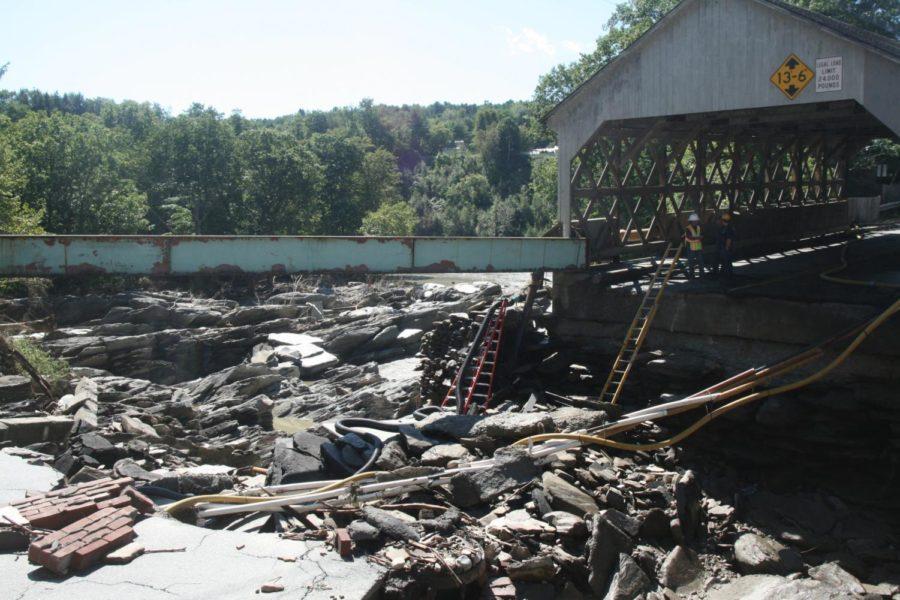Rescuers brave rising water to save families
Work continues on this covered bridge in Quechee, Vt. The bridge was severely damaged during the flash flooding of the Ottauquechee River. These views are from the north side of the river.
August 30, 2011
Search-and-rescue teams went door-to-door by boat Tuesday in flooded communities in the Northeast, transporting families from their homes to higher ground.
“The water’s moving so fast,” said Scott Evans of the New Jersey Office of Emergency Management. “It’s not even safe to go close to the river at this point.”
Evans spoke with CNN in Paterson, N.J., just three blocks from the swollen Passaic River.
Water in the street was as high as 15 to 18 feet, he said. Some one-story buildings were fully submerged.
Tuesday morning alone, 34 people, including 14 children, were rescued in Paterson along with three dogs, Evans said.
While people had been warned that river levels were rising and flooding was likely, some stayed in their homes overnight because they didn’t realize the water would come gushing so quickly, Evans said.
“Unfortunately, they are used to flooding, but not of this magnitude,” he said of local residents. “And a lot of areas are getting flooded this time that have not been flooded before.”
Some coastal communities along Irene’s path have been cut off, turned temporarily into islands.
In Grafton, Vt., 800 residents were stranded. “It’s one massive mess,” said Tara Taylor, who came out of Grafton to nearby Rockingham, along with her family. “There’s no words to describe this.”
While part of Grafton has maintained electricity, much of the town is running on generators, she said. But as far as she knew, people were well, and no one had been hurt, Taylor said. “We’ve been very lucky with this.”
Residents were checking on each other, she said.
Taylor’s young daughter told CNN she had seen pictures of some devastated areas. “It just tore me apart on how it was like all just gone,” she said.
Mark Bosma of the Vermont Office of Emergency Management said officials were bringing in supplies to cut-off communities. The National Guard operated with two helicopters, doing drop-offs where needed, delivering such necessities as food, water, food, medicine, diapers and formula.
A total of 13 Vermont towns had been inaccessible by roads early Tuesday. By late afternoon, Route 100 into Stratton and Rochester were open and officials said they hoped to have the remainder of those towns accessible by Tuesday night.
Meanwhile, the death toll stemming from Irene continued to rise. At least 43 deaths were linked to the storm, from Florida to North Carolina to New England.
An estimated 2.85 million customers remained without power Tuesday afternoon, the U.S. Department of Energy said. That included more than half a million each in Connecticut and New York, more than 400,000 in Virginia, more than 300,000 in New Jersey and more than 250,000 in Maryland.
Nearly 6.7 million customers initially were left without power by the storm, the department said.
“This storm covered a tremendous amount of territory,” Homeland Security Secretary Janet Napolitano told reporters in Virginia. She said most states are now in recovery, though a few states — like Vermont and New Jersey — are still in response mode.
Napolitano traveled to North Carolina and Virginia Tuesday with Agriculture Secretary Tom Vilsack to meet with state and local officials and to survey storm efforts.
Vilsack spoke to reporters in North Carolina after touring some of the hardest-hit areas. He said tobacco, cotton and corn producers suffered extensive damage.
“I’ve not seen the kind of flooding and damage to crops that I saw briefly today. And if this is representative of what North Carolina has suffered, it’s obviously a fairly significant blow to North Carolina agriculture,” he said.
The full extent of Irene’s damage won’t be known for some time. The federal government estimates that the cost from wind damage alone will exceed $1 billion. Analysts have put the total anticipated cost of Irene much higher.
CNN’s Julia Talanova, Mary Snow, Amber Lyon, Gary Tuchman, A. Pawlowski, Josh Levs, Joe Sutton, Nina Golgowski, Katie Silver, Ric Ward, Melanie Whitley and Jake Carpenter and iReport’s Nicole Saidi contributed to this report.















